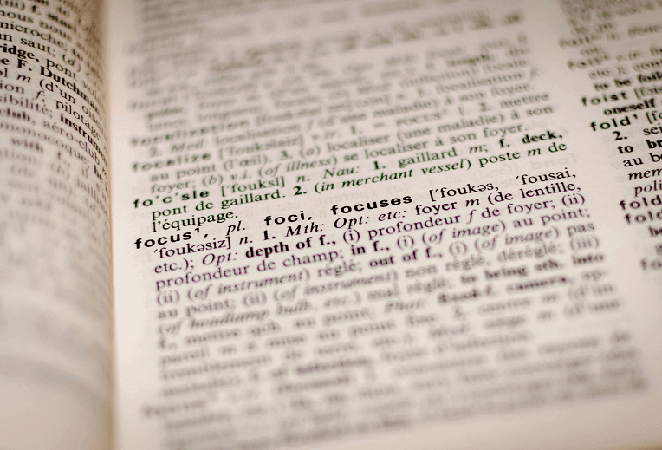In a blog titled “Words That Can Ruin Your Sentence,” Dictionary.com calls the unnecessary words we speak “crutch words.” In a recent tweet headlined “Words de Doom,” Appellate Twitter calls unnecessary words we write “verbal tics.” Whatever we call them, we use unnecessary words for a reason: when speaking, it’s to give ourselves time to think about what we want to say next—so, well, actually—when writing, it’s usually because we don’t know they’re unnecessary.
Our Three Vocabularies
Speaking and Writing are two of the three vocabularies we use to understand and communicate in our world. The third is our Reading vocabulary.
Of the three, our Reading vocabulary is by far the largest and the most complex. Our Speaking vocabulary is by far the smallest and the least grammatical, but listeners willingly forgive our ers and uhs and sos and wells, and especially our grammatical slips, because most of us can’t think fast enough on the fly to remember the difference between lay and lie. Somewhere between our Reading and Speaking vocabularies lies our Writing vocabulary, the one on which we hang our reputation with clients, colleagues, and judges.
No one is around to assess our Reading, and listeners forgive most of our slips when Speaking, but others judge our Writing incessantly and sometimes harshly. Unlike listeners, readers have time to consider our words, to re-read them, to determine if we’ve followed the rules, and to wonder where in all those words lies our meaning.
“Vigorous” Writing
Readers come to what we have written with a certain degree of confidence in us—that we have used each word for a reason. As they read, however, they begin to sense that maybe there’s no reason to use some of these words, and they shift into an automatic, subliminal, sorting-out process trying to determine, “Which words do I need to understand what this person’s trying to tell me?” In this sorting-out process, they slow in their reading, and they become more confused.
When we remove unnecessary words, two things happen: First, our readers have fewer words they must process to get the same meaning. Second, they do not have to search for words that convey meaning—because they all do. Although we will rarely achieve it, our goal should be to remove every meaningless word.
The most famous book on using words—William Strunk and E.B. White’s The Elements of Style—contains the teachings of Professor Strunk from over a century ago, and his musings resonate today. The most famous “rule” in The Elements of Style is 13 (or 17 in later versions): “Omit needless words.” It reads:
“Vigorous writing is concise. A sentence should contain no unnecessary words, a paragraph no unnecessary sentences, for the same reason that a drawing should have no unnecessary lines and a machine no unnecessary parts. This requires not that the writer make all sentences short, or avoid all detail and treat subjects only in outline, but that every word tell.”
Stricter word limits for litigators are one example of courts trying to keep us from rambling. They might add to Rule 13: A brief should have no unnecessary words. If we remove the words that do not convey meaning, we will have an easier time meeting these limits.
A Good Sign
In its tweeted list “Words de Doom,” Appellate Twitter gives 55 “commonly overused” words and phrases we can remove “at the end of [our] writing process,” for a clearer, more concise document; words like accordingly, as such, in any event, to be sure, in other words, suffice it to say, what is more, clearly, and the fact that. Words like these don’t “tell.”
Many years ago, while teaching lawyers how to improve their writing, I noticed “signs” that exist in all writing, certain words that often and reliably signal the presence of words we do not need to make our point. These word-signs appear all through the phrases above that Appellate Twitter recommends we remove: in, what, as, that, to be. Over several years, I found a dozen of these signs, and then I stopped seeing them, and I realized that the set was finite, which then made me wonder if we could use these signs to develop technology to recognize patterns of unnecessary words; not just detect accordingly and clearly and remove them, but understand the context in which these needless words appear and determine when we should leave them alone, and when we should remove them.
No Middle Ground
When we started our editing software company, our goal was to develop technology and algorithms that could search sentences and recognize words that add no meaning. There is no middle ground. Words are either helping us convey meaning, or they’re getting in the way of other words trying to help us convey meaning. Which is another way of saying what Professor Strunk advocated back in the late 19th century—no extra lines in a painting, no extra parts in a machine, no extra words in a sentence.
After 10 years of refining this process, and receiving nine patents, we not only can remove single words like accordingly and clearly, but we also can assess the context for tens of thousands of phrases and know which ones to remove. One example: the fact that can appear 26 ways—possibly more, we’re still looking—and we have to know in which of these 26 contexts the phrase is unnecessary and how to remove it without changing the meaning of the words around it. When writers push the “Rake” button, they must feel confident the software knows what to do.
The Wrap
Of the 55 words and phrases on the Appellate Twitter list, at least 16 are words that in the right context will convey meaning to a reader—however, never, none, perhaps; or and and but to start a sentence (E.B. White himself did that frequently). Rarely would we need to avoid these 16 words. That leaves 39 needless words and phrases on the list, and of those 39, WordRake knows when to remove 28 at the push of a button. This is the software we envisioned years ago, the personal editor that insists every word tell, to help us be the best writers we can be.
Here are examples of WordRake editing some of the unnecessary words and phrases mentioned in this article:
Accordingly, the The Plaintiff's judgment should be vacated.
As such, we We should ask the shareholders about their goals.
The goals would be fulfilled in any event.
To be sure, she She was the most qualified candidate.
The board was impressed; in other words, the project was approved.
Suffice it to say that our expert witness presented incontrovertible proof.
What is more, Also, they speak English fluently.
The imported truffles were clearly superior to the domestic product.
Despite the fact that Although manatees require fresh water to drink, they survive for long stretches in saltwater.
About the Author
Gary Kinder has taught over 1,000 writing programs for the American Bar Association, the Social Security Administration, PG&E, Kraft, Microsoft, and law firms like Jones Day, Sidley, and WilmerHale. His critically-acclaimed Ship of Gold in the Deep Blue Sea hit #7 on the New York Times Bestsellers List.







